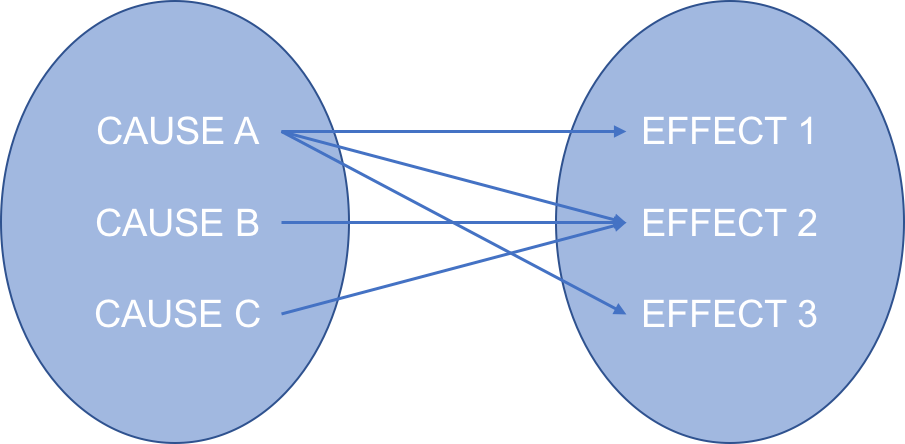For most organizations, adopting DevOps requires a mindset shift. Unless you understand the core of DevOps, you might think it's hype or just another buzzword—or worse, you might believe you have already adopted DevOps because you are using the right tools.
Let’s dig deeper into what DevOps means, and explore how to apply systems thinking in your organization.
What is systems thinking?
Systems thinking is a holistic approach to problem-solving. It's the opposite of analytical thinking, which separates a problem from the "bigger picture" to better understand it. Instead, systems thinking studies all the elements of a problem, along with the interactions between these elements.
Most people are not used to thinking this way. Since childhood, most of us were taught math, science, and every other subject separately, by different teachers. This approach to learning follows us throughout our lives, from school to university to the workplace. When we first join an organization, we typically work in only one department.
Unfortunately, the world is not that simple. Complexity, unpredictability, and sometimes chaos are unavoidable and require a broader way of thinking. Systems thinking helps us understand the systems we are part of, which in turn enables us to manage them rather than be controlled by them.
According to systems thinking, everything is a system: your body, your family, your neighborhood, your city, your company, and even the communities you belong to. These systems evolve organically; they are alive and fluid. The better you understand a system's behavior, the better you can manage and leverage it. You become their change agent and are accountable for them.
Systems thinking and DevOps
All systems include properties that DevOps addresses through its practices and tools. Awareness of these properties helps us properly adapt to DevOps. Let's look at the properties of a system and how DevOps relates to each one.
How systems work
The figure below represents a system. To reach a goal, the system requires input, which is processed and generates output. Feedback is essential for moving the system toward the goal. Without a purpose, the system dies.

If an organization is a system, its departments are subsystems. The flow of work moves through each department, starting with identifying a market need (the first input on the left) and moving toward releasing a solution that meets that need (the last output on the right). The output that each department generates serves as required input for the next department in the chain.
The more specialized teams an organization has, the more handoffs happen between departments. The process of generating value to clients is more likely to create bottlenecks and thus it takes longer to deliver value. Also, when work is passed between teams, the gap between the goal and what has been done widens.
DevOps aims to optimize the flow of work throughout the organization to deliver value to clients faster—in other words, DevOps reduces time to market. This is done in part by maximizing automation, but mainly by targeting the organization's goals. This empowers prioritization and reduces duplicated work and other inefficiencies that happen during the delivery process.
System deterioration
All systems are affected by entropy. Nothing can prevent system degradation; that's irreversible. The tendency to decline shows the failure nature of systems. Moreover, systems are subject to threats of all types, and failure is a matter of time.
To mitigate entropy, systems require constant maintenance and improvements. The effects of entropy can be delayed only when new actions are taken or input is changed.
This pattern of deterioration and its opposite force, survival, can be observed in living organisms, social relationships, and other systems as well as in organizations. In fact, if an organization is not evolving, entropy is guaranteed to be increasing.
DevOps attempts to break the entropy process within an organization by fostering continuous learning and improvement. With DevOps, the organization becomes fault-tolerant because it recognizes the inevitability of failure. DevOps enables a blameless culture that offers the opportunity to learn from failure. The postmortem is an example of a DevOps practice used by organizations that embrace inherent failure.
The idea of intentionally embracing failure may sound counterintuitive, but that's exactly what happens in techniques like Chaos Monkey: Failure is intentionally introduced to improve availability and reliability in the system. DevOps suggests that putting some pressure into the system in a controlled way is not a bad thing. Like a muscle that gets stronger with exercise, the system benefits from the challenge.
System complexity
The figure below shows how complex the systems can be. In most cases, one effect can have multiple causes, and one cause can generate multiple effects. The more elements and interactions a system has, the more complex the system.

In this scenario, we can't immediately identify the reason for a particular event. Likewise, we can't predict with 100% certainty what will happen if a specific action is taken. We are constantly making assumptions and dealing with hypotheses.
System complexity can be explained using the scientific method. In a recent study, for example, mice that were fed excess salt showed suppressed cerebral blood flow. This same experiment would have had different results if, say, the mice were fed sugar and salt. One variable can radically change results in complex systems.
DevOps handles complexity by encouraging experimentation—for example, using the scientific method—and reducing feedback cycles. Smaller changes inserted into the system can be tested and validated more quickly. With a "fail-fast" approach, organizations can pivot quickly and achieve resiliency. Reacting rapidly to changes makes organizations more adaptable.
DevOps also aims to minimize guesswork and maximize understanding by making the process of delivering value more tangible. By measuring processes, revealing flaws and advantages, and monitoring as much as possible, DevOps helps organizations discover the changes they need to make.
System limitations
All systems have constraints that limit their performance; a system's overall capacity is delimited by its restrictions. Most of us have learned from experience that systems operating too long at full capacity can crash, and most systems work better when they function with some slack. Ignoring limitations puts systems at risk. For example, when we are under too much stress for a long time, we get sick. Similarly, overused vehicle engines can be damaged.
This principle also applies to organizations. Unfortunately, organizations can't put everything into a system at once. Although this limitation may sometimes lead to frustration, the quality of work usually improves when input is reduced.
Consider what happened when the speed limit on the main roads in São Paulo, Brazil was reduced from 90 km/h to 70 km/h. Studies showed that the number of accidents decreased by 38.5% and the average speed increased by 8.7%. In other words, the entire road system improved and more vehicles arrived safely at their destinations.
For organizations, DevOps suggests global rather than local improvements. It doesn't matter if some improvement is put after a constraint because there's no effect on the system at all. One constraint that DevOps addresses, for instance, is dependency on specialized teams. DevOps brings to organizations a more collaborative culture, knowledge sharing, and cross-functional teams.
Conclusion
Before adopting DevOps, understand what is involved and how you want to apply it to your organization. Systems thinking will help you accomplish that while also opening your mind to new possibilities. DevOps may be seen as a popular trend today, but in 10 or 20 years, it will be status quo.







Comments are closed.